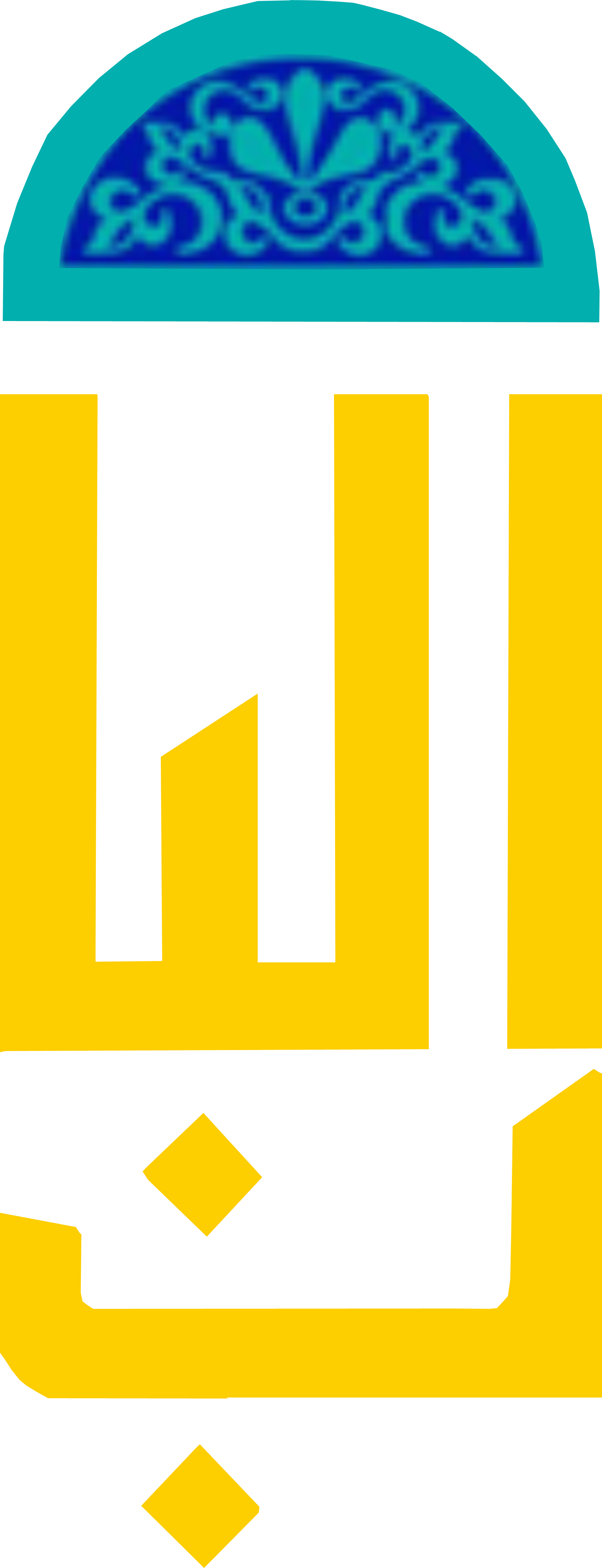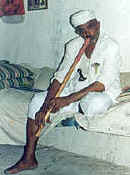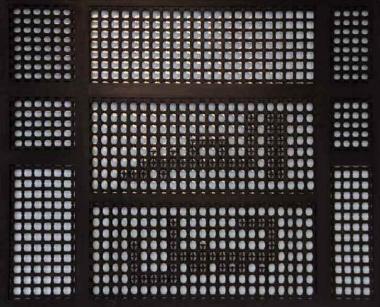This guide is divided into three sections: string instruments,wind instrumentsandpercussion instruments.Readers should bear in mind that construction of instruments varies according to musical tastes and local materials, and that similar instruments often have different names in different areas.
Stringinstruments
Buzuq
Levant and Iraq. A long-necked fretted lute with metal strings and a carved sound-box. Often associated with itinerant players. May be derived from the Turkishsaz.
Guenbri, ginbri, hajouje
North Africa. A deep three-stringed wooden bass instrument, sometimes with an added wooden resonator. Fretless, with a long cylindrical neck and a sound box covered with skin. In Morocco, often used byGnawamusicians.
Jawzah
Iraq. A four-string spike-fiddle. Sound box is part of a coconut shell covered with skin. One of the instruments traditionally used to accompanymaqamsinging.
Kaman,kamanjah
Nowadays this is the term for a western-style violin (though tuned to Arab musical requirements). Previously it referred to an Iranian violin, played vertically, which had been adopted by the Arabs. It is also a name sometimes given to therababah.
Lotar
A Berber lute, with three or four strings and a round body.
'Ud, Oud
Typically pear-shaped, short-necked and fretless, with five or six strings. It is played by plucking, either solo or in ensemble. The instrument has a warm timbre, low tessatura, and microtonal flexibility - which makes it extremely popular. It is often intricately decorated. "Al-'ud" is the origin of the English word, "lute".
Farhan Sabbagh and other 'ud masters
by John Absood
Qanun
A flat zither-type instrument with 26 strings which are played by plucking. The strings are tuned to the basic notes of a given scale and the pitch is raised or lowered by stopping the strings with a series of metal levers.
Rabab,rababah, rbab
A spike fiddle, traditionally used to accompany poetry. The Bedouin version has a quadrilateral sound box covered with skin and a single horsehair string. It is played with a horsehair bow. The Moroccan variant has a boat-shaped sound box and the string may be positioned to the side of the neck. In Egypt, the sound box is made from a coconut shell. Some versions have two strings. Seekamanjah.
Santur
Iraq: a hammer dulcimer with metal strings. One of the instruments traditionally used to accompanymaqamsinging.
Windinstruments
Arghul
Egyptian version of theyarghul.
Ghaytah, raita
Morocco: a wooden double-reed instrument, similar to the Tunisianzukrah.
Khallool
A metre-long flute with two playing holes at the far end. Thought to be one of the oldest wind instruments, and still played in the Tihama area of Yemen. Seearticle.
North Africa (especially Libya and Tunisia): a single-reed instrument with two horn bells. See alsomizwid.
Lebanon: this instrument has two identical reed tubes (the name means "paired" or "married"). Each tube has five or six holes and a smaller tube inside which vibrates to produce the sound. It is played using a circular breathing technique which produces a continuous sound, unlike a flute. See alsomitbiqandyarghul.
Levant and Iraq: a reed flute, open-ended and end-blown. It has a limited range and a breathy sound, which the player sometimes accomanpies by humming. Associated with weddings and dances, but also played by shepherds. See alsoshabbabah.
Iraq: a twin-tube instrument similar to themijwiz.
Mizmar(mizwijin Palestine)
In Egypt, a double-reed instrument. Normally three are played together, accompanied by a large double-sided drum (tabl).
Libya, Tunisia, Algeria: basically amaqrunahwith a bag attached, giving a bagpipe sound.
Nafir, N'far
Morocco: a three-metre long single-note horn made of copper. Used in ceremonial music and to awaken the faithful during Ramadan.
Nay
An open-ended reed flute, blown obliquely. With a wide range and breathy tone, it is highly expressive. and capable of producing dynamic and tonal inflections. The development and use of thenayhas been attributed to shepherds, but it is, in fact, an urban instrument. In Egypt, it is one of the instruments traditionally used in the ensemble known as atakht,("platform"). Also associated with Sufism.How to play the nay.
Qasabah
Southern Algeria, Tunisia: an end-blown reed flute used to accompany songs.
Raita
Seeghaytah
Salamiyyah
Egypt: an open-ended reed-flute associated with Sufism.
Palestinian version of theminjayrah.
Palestine: similar in principle to themijwiz,but only one of its tubes has holes; the other, which is longer, is used to produce an accompanying drone.
Zamr, zurna
Levant and Iraq: double-reed oboe-type instrument used to accompany dances.
Tunisia: a double-reed instrument similar to the Moroccanghaytah.
Zummarah
Egyptian version of themijwiz.
Percussioninstruments
Bendir, bandir
Morocco: goatskin-covered wooden drum, with two strings stretched across the underside, producing a distinctive distorted percussive sound.Used by Berbers in the Atlas mountains. Several may be played simultaneously.
Daff, duff
Generally a small tambourine. Also known as ariqq. Often used alongside thetablah.In Lebanon, thedaffis used typically by the performers of sung folk-poetry(zajal). In Egypt it is one of the instruments traditionally used in the ensemble known as atakht,("platform"). In Morocco, the instrument is a wooden-framed drum, entirely covered with stretched skin and played from both sides.How to play the daff/riq
Darbukkah, derbouka
Levant and Iraq: a hand-drum, usually conical or vase-shaped. May be made of pottery or metal. Also calledtablah.
Garagab, qarqaba, qaraqib
Morocco: metal clackers resembling double castanets. They are held two in each hand. Commonly used byGnawaperformers, particularly on festive occasions.
Gulf region: a clay pot played with both hands. Along with themirwas, this is one of the instruments used to accompany pearl fishermen’s songs(fijri).
Mazhar
Egypt: large tambourine with sets of cymbals.
Mihbaj
A large wooden coffee-grinder used (and played) by Bedouin. It consists of a decorative mortar, about a foot tall, and a two-foot pestle. Apart from its musical qualities, it is regarded as a symbol of affluence, status and hospitality.
Gulf region: a small double-sided hand drum. Along with thejahlah, this is one of the instruments used to accompany pearl fishermen’s songs(fijri).
Naqqarah
Morocco: double kettle drums made of pottery.
Qas'ah
Southern Tunisia: a large, shallow, kettle drum.
Qarqaba, qaraqib
Seegaragab
Riqq
Seedaff
Sajat
Small brass finger-cymbals used by dancers in Egypt.
Tabl, tablah
Typically, a large, cylindrical double-sided drum, played with the hand on one side and with a beater on the other. The name is widely used, though the instrument itself has regional variations.
Tar
Egypt: a large frame drum.
Taarija
Morocco: Smaller version of the derbouka, held in one hand and played with the other.
Tan-tan
Morocco: bongo drums.
Tbilat
Morocco: bongo drums made of clay pots covered with goatskin.
T’bol
Morocco: wooden drum covered with goatskin and played with light wooden sticks. Used in Gnawa ceremonies.



